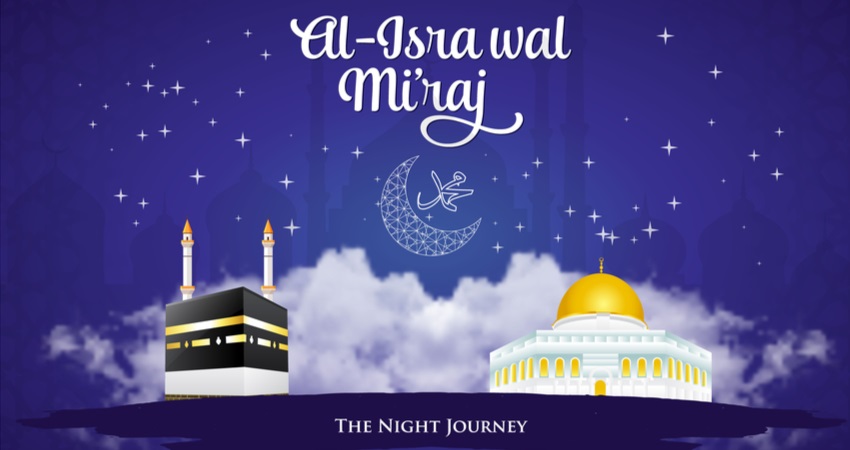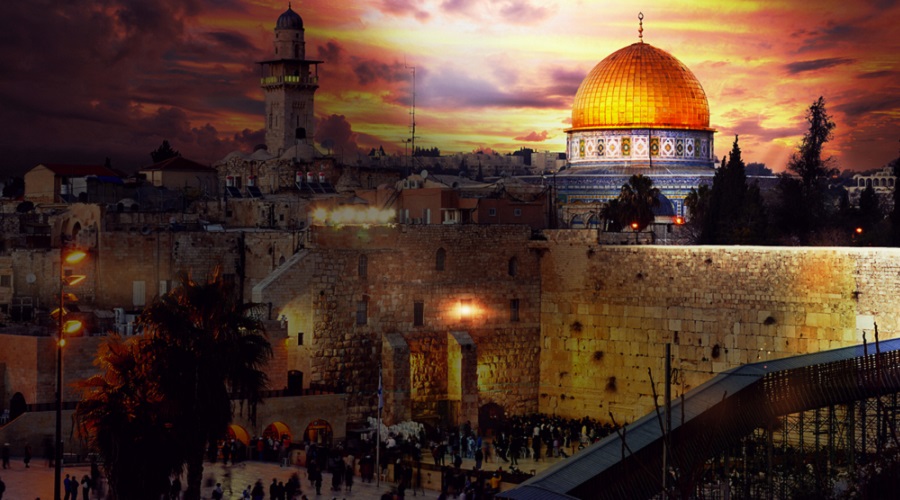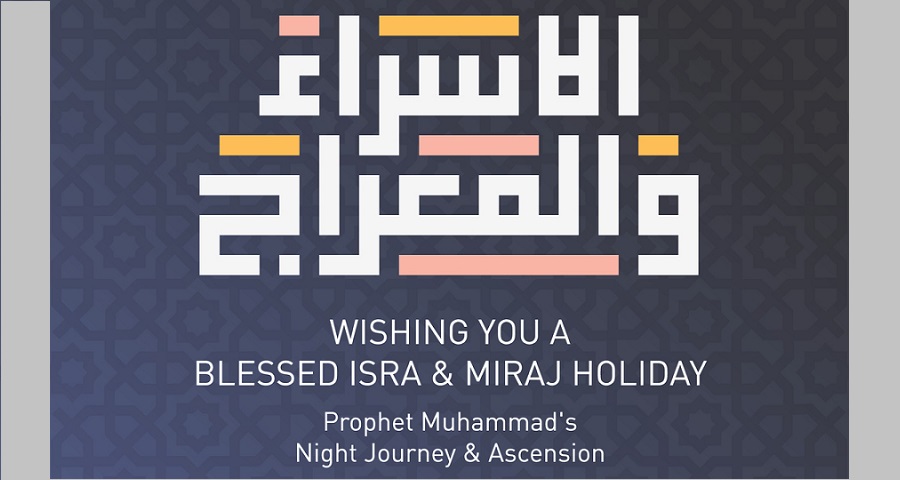Isra Miraj is one of the most notable events in the religious history of Islam, in which Isra and Miraj are two chapters of the night journey taken by Prophet Muhammad (PBUH) around the year 621. Certain events that took place during Isra and Miraj are explained in brief in the Quran.
The Story of Isra and Miraj
In Isra – the first part of the night, Prophet Muhammad’s (PBUH) journey began when he was in the Great Mosque in Makkah where angel Jibreel and angel Mikal came to him and brought Buraq (a creature in Islamic tradition said to be a transport for certain prophets). The Prophet travelled to Al-Aqsa Mosque in Buraq within a second. Anas Ibn Malik narrates that angel Jibreel offered Prophet Muhammad (PBUH) a glass of milk and a glass of wine, setting eyes on what he would choose. The Prophet drank milk which resulted in passing the special test as he chose the drink that was healthy and pure for him rather than the one that is prohibited on earth.
In Miraj, the second part of the Journey, Prophet Muhammad (PBUH) ascended to seven stages of heaven with the angel Jibreel. In each stage, the Prophet met and spoke to different prophets. At the first stage, he met Adam who is described as a tall and handsome man with long hair by Ibn Ishaq. In the second stage, he met Yahya (John the Baptist) and Isa (Jesus); after that he met Yusuf (Joseph) in the third stage who is described to be winsome like the moon. Then the Prophet met Idris (Adris) in the fourth stage, and after that Harun (Aaron) in the fifth stage who was described as the most beautiful man that Prophet Muhammad (PBUH) encountered. In the sixth stage, he met Musa (Moses) who is described to be distinctive from other prophets. Lastly, he met Ibrahim (Abraham) in the seventh stage who resembled Prophet Muhammad (PBUH) pointing up to be his father who was seen leaning on the lote tree known as Sidrat-Al-Muntaha.
Suggested Read: Life After Death In Islam: The Concept And The 14 Stages Of Afterlife
What is Sidrat-Al-Muntaha?
It is a huge Sidr tree as well as the end of the seventh heaven. According to Islamic beliefs, this is the boundary no one ever passed except Prophet Muhammad (PBUH) along with angel Jibreel. This is where Allah told Prophet Muhammad (PBUH) that Muslim believers were to enrol in prayers 50 times a day. The Prophet accepted the offer but as he was going back to the earth, he met Prophet Moses who advised that 50 prayers were too much for a day. Prophet Muhammad (PBUH) went back to Allah and requested to reduce 50 prayers as it was too much. Allah reduced 5 prayers and made it 45 prayers a day. But according to Prophet Moses, it was still too much. Prophet Muhammad (PBUH) took nine trips between Moses and Almighty Allah and after that, it was finally reduced to 5 times prayers a day. Prophet Moses continued to ask for the reduction in numbers, but Prophet Muhammad (PBUH) said that he was too guilt-ridden. Moreover, he is grateful for 5 prayers a day.
Suggested Read: 4 Types Of Prayers In Islam: Fard, Wajib, Sunnah, And Nafl
What is Lailat al Miraj?
Celebrated on the 27th of Rajab, Lailat-Al-Miraj is a Muslim holiday in the event of Isra and Miraj. It is also known as Mehraj-Ul-Alam and Shab-e-Miraj . Lailat-Al-Miraj meaning and history recognize it as the day when Prophet Muhammad (PBUH) ascended to all the seven stages of heaven. It is believed that this was the day when an angel visited and Prophet Muhammad’s (PBUH) chest was opened and it was purified with Zamzam water. Later his heart was filled with sagacity and belief. The day is celebrated differently by various Muslim countries. Most Muslims do not fast on this day since the exact day is not known. Food and treats are served after Salah (prayers performed by the Muslims).
How to celebrate Lailat al Miraj?
Lailat al Miraj is the day when Muslims remember the holy night of Isra Miraj. It is marked by congregation prayers in mosques. Prayers can be performed at home as well, followed by celebration meals. Some Muslims also light candles to mark this special day. At home, elders of the family share the story of Isra and Miraj with the young to ensure that the legend as well as the tradition is passed on to the generations to come. Some people also recite night time prayers for Shab-e-Miraj. Fasting on Lailatul-Miraj is optional but not common. It is said that if someone fasts on this day, they will be safe from Qabr ka Azab, which means the azab of the grave. They will also be safe from Dozakh, or the fire of hell. Hence, Huzur Sallalahu Alaihi Wa Salam recommended fasting on the two days of Shab E Meraj.
Prophet Muhammad’s (PBUH) Spiritual Experience
Isra and Mi’raj represent a profound spiritual experience for the Prophet Muhammad (PBUH). It consists of two parts: the night journey (Isra) and the ascension (Mi’raj).
The Isra marked the physical journey of the Prophet from Mecca to Jerusalem, highlighting his unique position as Allah’s chosen messenger.
The Mi’raj signifies the ascension through the heavens, where the Prophet met various prophets and ultimately stood in the presence of Allah.
This spiritual journey reinforced the Prophet’s mission, emphasizing the significance of his role as a bridge between humanity and the divine.
Lessons and Teachings
Isra and Mi’raj offer several important lessons and teachings for Muslims:
Faith and Belief: These events reinforce the importance of unwavering faith and belief in the unseen, as the journey involves supernatural elements.
Spiritual Ascent: They symbolize the concept of spiritual ascent and the potential for personal growth and closeness to Allah through devotion and worship.
Prophetic Mission: Isra and Mi’raj underscore the role of Prophet Muhammad as the final messenger and his unique connection with Allah.
Prayer and Worship: The night is a reminder of the significance of prayer and worship in the life of a Muslim.
Commemoration and Celebration
The night of Isra and Mi’raj is commemorated by Muslims on the 27th day of the Islamic month of Rajab.
Muslims may engage in various activities to commemorate this event, including:
Night Prayers (Qiyam-ul-Layl): Many gather at mosques for special night prayers, recitation of Quranic verses, and supplication.
Reflection and Remembrance: Muslims take time for introspection, seeking to strengthen their faith and connection with Allah.
Recitation of Quran: It is common to recite and reflect upon Quranic verses that pertain to the themes of faith, the Prophet’s mission, and spiritual growth.
Commemorating Isra and Mi’raj is a time for spiritual rejuvenation and an opportunity to draw closer to Allah through prayer and reflection. It serves as a reminder of the Prophet’s extraordinary journey and the enduring lessons it imparts.
Isra Miraj Hadith
Anas ibn Malik reported: Fifty prayers were obligated upon the Prophet, peace and blessings be upon him, when he was taken on his night journey. Then, it was reduced until it was set at five and an announcement was made, “O Muhammad, My word is never changed, so these five prayers will be counted as fifty.”
Source: Sunan al-Tirmidhī 213
Ibn Mas’ud reported: The Messenger of Allah, peace and blessings be upon him, said, “I met Abraham on the night of my Ascension and he said: O Muhammad, greet your nation with peace from me. Tell them Paradise has pure soil and delicious water, that it is a level plain and its plants grow with declarations of the glory of Allah, the praise of Allah, the oneness of Allah, and the greatness of Allah.”
Source: Sunan al-Tirmidhī 3462
Abu Huraira reported: On the night of the Ascension, the Prophet, peace and blessings be upon him, was presented with two vessels, one full of wine and the other full of milk. The Prophet looked at them both and he chose the vessel full of milk. The Angel Gabriel, upon him be peace, said, “All praise is due to Allah who has guided you to that which is natural, for had you selected the wine your nation would have been led astray.”
Source: Ṣaḥīḥ al-Bukhārī 4432, Ṣaḥīḥ Muslim 168
Anas ibn Malik reported: The Messenger of Allah, peace and blessings be upon him, said, “I passed by Moses during my night journey near the red mound; he was praying in his grave.”
Source: Ṣaḥīḥ Muslim 2375
Malik ibn Sa’sa’ah reported: The Prophet, peace and blessings be upon him, told them about his Night Journey, saying, “We ascended until we reached the second heaven where Gabriel asked for the gate to be opened, but it was said: Who is it? Gabriel said: I am Gabriel. It was said: Who is with you? Gabriel said: It is Muhammad. It was said: Has he been called? Gabriel said yes. When we reached beyond the second heaven, I saw John and Jesus who are cousins. Gabriel said: These are John and Jesus, so greet them with peace. I greeted them with peace and they returned my greeting, saying: Welcome, O righteous brother and prophet.”
Source: Ṣaḥīḥ al-Bukhārī 3247, Ṣaḥīḥ Muslim 164
Isra Miraj is one of the key events in the religious history of Islam. Lailat-Al-Miraj is an important day for Muslims and is observed differently. And the fact that it is explained in such detail in the hadiths makes it an important day for Muslims around the world.
Isra Miraj FAQs
What is the meaning of the word Isra?
The word Isra is an indirect Quranic name for girls which means Night Journey. In the history of Islam, it refers to the journey of Prophet Muhammad (PBUH) from the Great Mosque in Makkah to Al-Aqsa Mosque in Jerusalen within a second.
What is the meaning of the word Miraj?
The word is from Arabic, which means Ladder. Its religious significance comes from the holy journey of Prophet Muhammad (PBUH) to the seven stages of heaven along with the angel Jibreel.
What is Shab-e-Miraj?
Shab-e-Miraj is another name for Lailat-Al-Miraj, just like Mehraj-Ul-Alam. It is Muslim holiday observed on the 27th of Rajab in the Islamic calendar each year. It is an important event that marks the day when Prophet Muhammad (PBUH) ascended through all the seven stages of heaven to reach Sidrat Al Muntaha.
From where did the Night Journey start?
The Prophet’s night journey of Isra started from Mecca - the holiest city in Islam.
When did Isra and Miraj take place?
Though the exact date of Isra Miraj is unknown, a majority of Islamic scholars believe that it is observed on the 27th day of Rajab.
What is the difference between Isra and Miraj?
Isra is the journey that Prophet Muhammad (PBUH) conducted from Al Haram Mosque in Makkah to Al Aqsa Mosque in Jerusalem. Whereas, Miraj is the ascension of the Prophet from Jerusalem to Heavens.
How long did the journey of Isra and Miraj last?
The real number of days the journey lasted is unknown as the focus is given more on the miraculous nature of the journey rather than its duration.
What is Isra and Miraj, and what do the terms mean?
Isra is the journey that Prophet Muhammad (PBUH) took from Makkah to Jerusalem. While Miraj is the ascension of the Prophet from Jerusalem to Heaven.
The event of Isra and Miraj is not mentioned in the Quran. However, there are many hadiths relating to the journey.
How is the Isra and Miraj event celebrated or commemorated by Muslims?
Muslims gather at the mosque and read Quranic verses while reflecting on their lives on the night of Isra and Miraj.
Are there any lessons or teachings that Muslims derive from the Isra and Miraj story?
Yes the story highlights and tells us about the importance of faith and belief, spiritual ascent that we all can go through, mission of the Prophet, and prayers.











